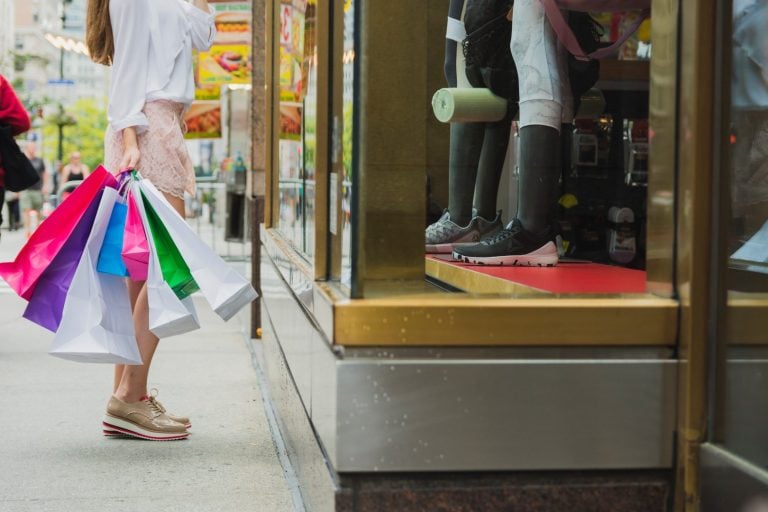In 2024, we stand at a crossroads in the world of retail. Brick-and-mortar stores, once the unchallenged kings of commerce, now face an existential crisis. But is their fate truly sealed?
Picture this: You’re walking down a bustling city street. To your left, a “For Lease” sign hangs in the window of what was once a thriving bookstore. To your right, a line snakes out the door of a trendy pop-up shop. This stark contrast captures the current state of physical retail – a world of rapid change, adaptation, and reinvention.
The numbers tell a compelling story. In the U.S. alone, over 12,000 brick-and-mortar stores closed their doors in 2023, a staggering figure that sent shockwaves through the industry. Yet, paradoxically, we’re also witnessing a renaissance of physical retail experiences, with brands like Apple and Nike creating stores that are more akin to interactive museums than mere points of sale.
So, what’s really happening here? Are successful brick-and-mortar stores dinosaurs facing extinction, or are they evolving into something entirely new?
The truth, as always, is far more nuanced and fascinating than the headlines suggest. In this comprehensive review, we’ll peel back the layers of the brick-and-mortar debate, examining both the undeniable advantages of brick-and-mortar locations and the critical challenges facing physical stores in 2024.
Whether you’re a business owner, a consumer, or simply someone intrigued by the shifting landscape of how we buy and sell, buckle up. We’re about to embark on a journey through the past, present, and future of retail – and what we discover might surprise you.
Metrobi drivers are rated 4.97/5
Trusted by local businesses for:
- Background-checked professionals
- Specialized in business deliveries
- Same drivers for consistency
- 4.97/5 average delivery rating
What is a Brick-and-Mortar Store?
Physical stores where people shop face-to-face.
Different from online shopping.
Brick-and-mortar stores are everywhere. People go there to touch and see what they want to buy. It’s simple. You can walk inside, check things out, and decide if you want to buy them. This makes these stores different from online shopping.
Examples of Brick-and-Mortar Stores
Department stores, like Macy’s or Nordstrom, sell many things—clothes, shoes, home goods—all under one roof. Specialty shops, such as electronics or gadget stores, focus on one type of product.
Supermarkets, and traditional retailers such as Walmart, are another type. You can buy groceries and household items there. Then, there are local convenience stores like 7-Eleven for quick and small buys. Some people also shop at shopping malls, which house many different stores.
Brick-and-mortar stores meet various needs. They vary in size and what they sell. They are the go-to places for many people.
Types of Brick-and-Mortar Stores
Department Stores
Department stores are big. They sell a wide range of products in one place. This makes them convenient for customers who wish to buy many different items at once. With many sections—clothing, electronics, and more—it’s like a one-stop-shop.
They are usually located in large retail spaces or malls. This one retail location attracts many customers in one area. Customers can compare prices and brands easily. These stores thrive due to their variety and convenience.
Specialty Stores
Specialty stores narrow their focus. They deal in one product category like shoes, books, or gadgets. Think of Apple stores or Tiffany & Co. These stores cater to niche market needs. Customers often go for expertise and quality.
Specialty stores often provide recommendations that match specific needs. Shoppers value detailed knowledge over a broad selection. This invites enthusiasts and pros alike to find exactly what they are looking for.
Common Misconceptions About Brick-and-Mortar Stores
“Is this an example question?” is often asked online. Let’s clear that up. Brick-and-mortar refers directly to physical structures for physical retail presence. It doesn’t mean any business with a physical presence, like warehouses or factories.
People often ask: “What are some examples of common questions?” One example is asking if traditional stores are dead. Not at all. For those looking for inspiration on how to enhance their physical retail spaces, exploring various brick-and-mortar store examples can provide valuable insights. To discover some standout examples that can inspire your business, check out this article on inspiring brick-and-mortar establishments.
In-Store Shopping Remains Dominant
Approximately 15.4% of all retail sales are conducted online, while 84.6% still occur in-store.
Another question is: “What is the question definition with example?” A question asks for information. For example, “What types of stores are brick-and-mortar?”
Sometimes, people wonder how to shop there. It’s easy. Ask store staff for item locations, compare items in front of you, and decide with your hands, not just your eyes. Remember, stores have experts on hand to help.
Physical stores remain strong in retail today. They provide a unique shopping experience and meet needs online shopping can’t. Understanding brick-and-mortar stores helps in seeing their role in today’s world. This prepares us for exploring further into their benefits.
Benefits of Brick-and-Mortar Stores
Direct sensory engagement with products.
Immediate customer satisfaction and service.
Job creation boosts the local economy.
Physical Retail Experience
Brick-and-mortar stores provide an immediate, sensory experience that online shopping cannot replicate. Shoppers can see, touch, and even smell products before making a purchase. This direct engagement allows consumers to evaluate the quality, size, and color of items firsthand, reducing the risk of receiving something unexpected. For instance, clothing shoppers can feel fabric textures and ensure proper fit without the hassle of returns, which is often a gamble with online purchases.
Physical Stores Are Still Prevalent
Among U.S. multichannel retailers with physical locations, 83.7% have at least one brick-and-mortar store.
The Power of Physical Product Interaction
For 56% of consumers, the ability to touch and try products is the main draw of in-store shopping.
Additionally, these stores provide instant gratification. Instead of waiting days for delivery, customers leave with their purchases in hand. This aspect is particularly appealing during important occasions when gifts or essentials are needed without delay. Physical shops also boast attentive in-person customer service. Knowledgeable staff can provide real-time assistance, answer questions, and offer advice, creating a more personalized shopping experience. For example, a customer looking to buy a TV can benefit from expert guidance on features and pricing.
Other Reasons Why Consumers Prefer Phsical Shopping
Product appearance inconsistencies (41%), extended delivery wait times (34%), exorbitant shipping fees (25%), and cumbersome return policies (16%) all contribute to consumers' preference for in-store shopping.
Dive Deeper
“Why We Buy: The Science of Shopping” by Paco Underhill explores consumer behavior in physical stores.
Check out podcasts like “Retail Gets Real” for industry trends and insights.
The course “Customer Experience Management” on Coursera offers tools to enhance in-store experiences.
Advantages Over Online Shopping
Despite the rise of e-commerce, brick-and-mortar stores offer several key advantages over online shopping. These physical spaces stimulate impulse buying through visual merchandising. Attractive displays, strategic product placements, and themed decorations entice customers to purchase more than they initially intended. This is a thrilling tactic often missing from the mostly online sales world. For instance, grocery stores often place treats near the checkout, sparking last-minute buys.
Physical Shopping Preference Over Online Shopping
About 49% of Americans prefer shopping at brick-and-mortar stores, indicating a strong preference for physical shopping experiences.
Supporting the local economy is another significant benefit. Physical stores create jobs, from sales associates to managerial roles, contributing to regional economic health. Local hiring not only reduces unemployment rates but also fosters community connections. Furthermore, businesses often source products from nearby suppliers, boosting small enterprises and maintaining sustainable practices.
The E-commerce Job Drain
Retail employment growth drops by 2.9% in counties with the establishment of new ecommerce fulfillment centers, equating to a loss of approximately 938 jobs per county per quarter.
Dive Deeper
“Retail Revival” by Doug Stephens offers insights on adapting stores to modern consumer needs.
The podcast “eCommerceFuel” debates the future of physical retail and online shopping.
LinkedIn Learning has courses focused on visual merchandising and retail management.
Action Items
Analyze recent studies on shopping behaviors in brick-and-mortar stores for strategic insights.
Experiment with visual merchandising techniques to enhance in-store experiences.
Support local businesses by collaborating with nearby suppliers or artisans.
Reasons People Still Shop In-Person
There are various reasons why people still prefer shopping in person. One of the most compelling reasons is the social interaction it provides. Shopping becomes a shared experience, allowing interactions with others, which is often missing online. Visiting a shopping center or store gives a sense of community and connection. For some, wandering through the aisles with friends is a routine weekend activity, offering both social and entertainment value.
Security and trust also drive many to choose physical stores over online shops. Consumers often feel more confident buying big-ticket items in person, reducing fear of scams or complicated return processes. They appreciate the transparency of seeing the actual product before purchase, knowing exactly what comes with it, and having instant clarity on warranties or policies. Experiences in sectors like luxury goods and real estate highlight this value, where tangible evidence of quality and authenticity plays a critical role.
Dive Deeper
“The Experience Economy” by B. Joseph Pine II delves into how experiences drive modern consumer choices.
Retail Dive offers current articles on the blend of physical and digital shopping.
For further learning, consider courses on consumer psychology offered by Udemy.
Action Items
Visit local stores to observe customer engagement strategies.
Consider consumer security measures to build trust in-store.
Use insights from community-focused shopping studies for marketing strategies.
Tip: Stay informed about relevant stats and trends as the retail environment evolves.
Support for Local Economies
Brick-and-mortar stores benefit local economies by providing jobs and stimulating local businesses. For every $100 spent locally, $68 stays within the economy, compared to $43 for national chains or online retailers.
Disadvantages of Physical Stores
High expenses in operations.
Limited market coverage.
Inventory challenges and space limitations.
Brick-and-mortar stores have some challenges that online businesses must consider. Let’s explore these issues deeply.
High Operational Costs
Financial Strain of Operational Expenses
The physical presence of a store means higher costs, starting with rent. Retail spaces in prime locations can cost a lot. Utilities such as electricity and water add to this financial load. The need for staff amplifies expenses with regular salaries and benefits. According to Digital Authority Partners, these costs are a substantial burden on store owners. Leaner inventory processes could help lower overhead costs, but that is difficult without significant changes to operations.
Inventory Management and Loss
Theft and damage are significant concerns in retail environments. Protecting inventory requires investment in security measures like surveillance cameras and alarm systems. Installing high-quality security cameras can significantly enhance store safety and reduce losses from theft. Still, theft occurs, affecting profit margins. Stock damage, whether from mishandling or environmental factors, also causes losses. Effective inventory strategies can mitigate these issues but can add more to operational costs.
Limited Reach
Dependence on the Local Customer Base
Physical stores rely heavily on local customers. This geographical constraint limits local business’ market reach compared to online retailers. A store might perform well in a community but is unable to expand its customer base without additional locations. Businesses must understand this trade-off when planning expansion.
Impact of External Factors
The success of brick-and-mortar stores is tied to external factors like weather conditions. Bad weather can deter customers, directly impacting sales for the day. Events such as road works can decrease foot traffic over extended periods. A store’s physical location also can be a double-edged sword, offering prime visibility at the cost of vulnerability to these factors.
Average Foot Traffic of a Brick and Mortar Businesses
The average consumer visits a brick-and-mortar store approximately 70% weekly, showcasing strong foot traffic trends.
Inventory Limitations
Space Constraints
The inability to store a wide range of products is a common issue. Limited physical space means fewer items can be displayed and stored. It also restricts the ability to test new products or expand existing lines. For example, a bookstore might not carry both rare and popular titles due to shelving space.
Logistical Challenges
Managing stock is a complex task. Physical stores often need to predict customer demand accurately to avoid overstocking or bottlenecks in supply chains. Excess inventory takes up valuable space while understocking can lead to lost opportunities. Handling these logistical concerns requires sophisticated inventory systems.
Alternative Perspectives on Physical Store Challenges
Critics argue that the costs associated with maintaining a physical store are too high. However, proponents suggest these stores offer unique community building and customer experience advantages that digital platforms cannot replace. Books like “Why We Buy: The Science of Shopping” by Paco Underhill explores how customers interact with physical retail spaces, suggesting that the sensory experience is invaluable.
To explore this further, investigate the effects of operational costs on small businesses in the retail sector. Scholarly articles such as those found in the Journal of Retailing offer a deep dive into these issues.
How Brick-and-Mortar Stores Work
Customers visit physical stores during business hours for in-person shopping.
Employees assist and manage store operations.
Step #1: Store Setup and Layout
Brick-and-mortar stores rely on strategic layouts to enhance customer experience and boost sales. The arrangement of products in different sections is vital. This setup considers customer needs, product categories, and store size. Effective store design often involves scientific methods to determine optimal traffic flow and product placement. Books like “Why We Buy: The Science of Shopping” by Paco Underhill delve deeply into retail design principles that influence consumer behavior. Concepts such as the “decompression zone” near entrances and the use of visual merchandising can significantly impact sales.
Furthermore, creating an inviting environment involves striking the right balance between aesthetics and functionality, ensuring that customers can navigate easily while being enticed to explore different sections. Store design also reflects brand identity, offering a cohesive sensory experience. Tory Burch’s approach underscores this: she views her stores as extensions of her brand’s persona, making customers feel at home.
Step #2: Customer Service Process
Personnel at physical stores must be adept at handling customer inquiries and complaints. Training programs are critical to equip employees with skills to provide top-notch service. According to Damon Richards, trust is built not through knowledge alone, but by showing customers genuine care. This is reflected in how staff engage with patrons, resolve issues, and create a welcoming atmosphere.
Service training might include conflict resolution, active listening, and product knowledge, empowering employees to assist effectively. In high-end retail, a strong focus on personalized service can differentiate a store from competitors. The human element in physical stores is paramount, as it forms the foundation for long-term customer loyalty and engagement.
Step #3: Inventory Management
Inventory management in brick-and-mortar stores involves sophisticated strategies to balance supply and demand. This includes real-time tracking, forecasting, and restocking to minimize stockouts and overstock situations. Stores often leverage software solutions like enterprise resource planning (ERP) systems to streamline these operations. The book “Inventory and Production Management in Supply Chains” by Edward A. Silver et al. provides comprehensive insights into these techniques.
Calculating reorder points and maintaining safety stock levels are vital components of effective inventory management in-store experience. Additionally, loss prevention strategies are crucial, given the physical risks of theft and damage in-store. Retailers must implement security measures such as surveillance systems and security tags as part of their inventory control.
Step #4: Marketing and Promotions
Retail marketing for physical stores encompasses a variety of in-store and external activities. In-store promotions might include seasonal sales, loyalty programs, and special events designed to draw foot traffic. Effective visual displays and signage further support these initiatives by capturing customer attention and encouraging purchases.
External marketing efforts may involve local advertising, social media campaigns, and partnerships with nearby businesses. For a deeper exploration into retail marketing, “Retail Marketing Management: Principles and Practice” by David Gilbert offers a detailed overview of strategies applicable to physical stores. Marketing in this context is not just about attracting customers but also about retaining them by enhancing their shopping experience through loyalty initiatives and personalized offers.
Step #5: Performance and Feedback Analysis
Brick-and-mortar stores continuously analyze performance metrics to refine their operations. Key metrics include sales per square foot, customer footfall, and conversion rates. Feedback from customers plays an essential role in this analysis, helping stores identify areas for improvement and innovation. Many businesses utilize customer surveys and feedback platforms to gather insights on their shopping experience.
Improve Your Store's Traffic Insights
Only about 25% of major retailers track store traffic, emphasizing a potential area for improvement in data utilization for physical stores.
Analyzing sales patterns and customer behaviors can lead to data-driven decisions on product placement, promotions, and stock management. Advanced topics like retail analytics, covered in books such as “Analytics for Retail” by Natalie W. Nixon, delve into methodologies for interpreting such data to drive business growth. Incorporating technology for feedback collection and performance evaluation creates a cycle of continuous improvement, ensuring that stores meet evolving consumer expectations.
Leveraging Retail Analytics
McKinsey & Company found that apparel retailers using analytics improved profits by 2-10%. Larger analytics implementations yielded tenfold returns on investment.
Future of Retail Shopping
Tech-driven change in physical retail settings.
Enhanced shopper experiences becoming a key focus.
Bridging the digital and in-person shopping gap.
Merging Online and Offline
As retail evolves, the lines between online and offline shopping continue to blur. Brands are moving towards hybrid shopping experiences that combine the convenience of online with the tactile satisfaction of in-store shopping. This integration allows businesses to engage customers through multiple touchpoints, enhancing customer loyalty and expanding their market reach. Innovations such as augmented reality (AR) and virtual reality (VR) are being used to allow customers to visualize products in their homes before purchasing, creating a seamless shopping journey from digital devices to physical aisles.
Consumers Demand Integrated Retail
A strong majority (84%) of consumers believe retailers need to improve the integration of online and offline shopping.
Click-and-collect services have seen a significant rise in popularity, catering to the consumer demand for flexibility in how they receive their purchases. Shoppers value the ability to browse and purchase items online, and then pick them up at a nearby store at their convenience without waiting for home delivery. This also benefits retailers by reducing shipping costs and driving additional foot traffic into stores, where shoppers may make additional unplanned purchases.
Books like “Omnichannel Retail: How to Build Winning Stores in a Digital World” by Tim Mason and Miya Knights provide deeper insights into these hybrid models. The book emphasizes how crucial it is for retailers to create a unified and engaging experience across all sales channels, calling for a strategic embrace of both digital and physical elements.
Adapting to Evolving Customer Preferences
Understanding and adapting to customer preferences is pivotal in today’s retail environment. Personalized shopping experiences, facilitated by data analytics, are becoming a standard expectation. Retailers leverage customer data to tailor offers and recommendations, thereby increasing the likelihood of purchases and customer satisfaction. Gartner predicts that by 2025, personalization will manage over 80% of the customer’s shopping experience without direct human involvement.
In-store, retailers are enhancing this personalized approach by using technology like smart mirrors and mobile apps, which allow consumers to explore more tailored product suggestions. Stores that use these advanced tools can provide recommendations based on previous purchases or browsing history, all accessible in-store or via personal devices.
To understand further, “The New Rules of Retail: Competing in the World’s Toughest Marketplace” by Robin Lewis and Michael Dart delves into how retailers are revolutionizing their business model and their strategies to capture this shift in consumer behavior. The book highlights the critical role of technology in understanding and meeting consumer needs efficiently.
Enhancing Convenience and Satisfaction
The drive for convenience is reshaping how stores operate both in physical spaces and online. Shoppers expect easy returns, minimal wait times, and user-friendly interfaces, whether browsing an online catalog or navigating a physical store. The rise of self-checkout and mobile payment options underlines this trend. These options decrease wait times, offering a faster, more autonomous shopping process.
Online, retailers must ensure their websites and apps are responsive, intuitive, and aligned with their in-store offerings. This cohesion guarantees customers a consistent experience regardless of shopping mode.
For those keen on diving deeper into consumer satisfaction strategies, “Consumer Behavior: Buying, Having, and Being” by Michael R. Solomon provides a comprehensive guide. The book touches on psychological and social factors influencing consumer decisions, offering retailers insights into the consumer mind and how to align services to meet these psychological needs effectively.
Keeping pace with these advancements means regularly updating tools and practices to remain relevant. As technology and consumer preferences evolve, so too must the strategies employed by brick-and-mortar stores, ensuring they continue to provide an engaging and effective shopping experience.
Augmented Reality Trend
Current tech trends in retail stores show that approximately 61% of consumers prefer shopping with retailers that offer AR experiences.
Conclusion
Brick-and-mortar stores stand at a crossroads in 2024. They face challenges from online giants, yet hold unique strengths. The physical retail experience offers irreplaceable benefits: touch, smell, and immediate satisfaction. Local economies thrive on these businesses, creating jobs and community hubs.
Yet, high costs and limited reach pose significant hurdles. The future of retail lies in blending digital convenience with in-person customer experiences well. Stores that adapt, offering personalized service and seamless online-offline integration, will thrive.
As consumers, we shape this future. Our choices determine which stores survive and how they evolve. By supporting local businesses, we invest in our communities. By embracing new retail technologies, we push innovation forward.
The story of brick-and-mortar isn’t ending—it’s transforming. Each purchase is a vote for the retail landscape we want to see. So, next time you shop, consider: What kind of retail world do you want to build? Your decision matters more than you know.













